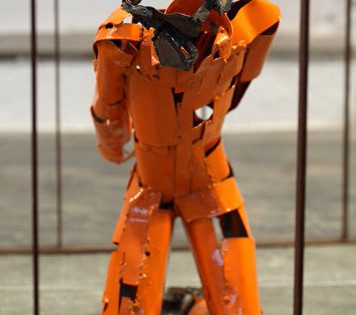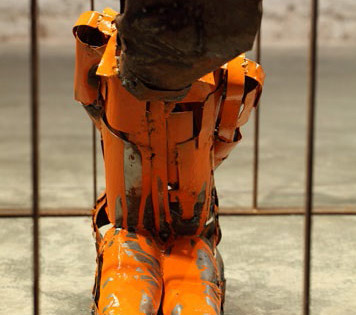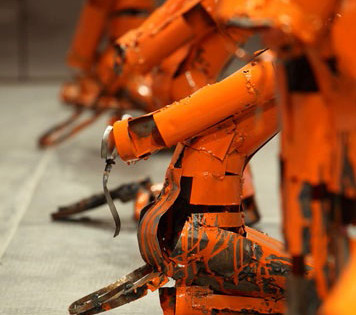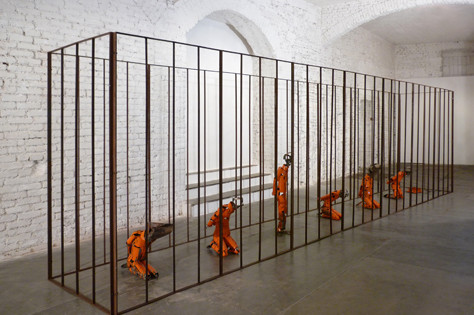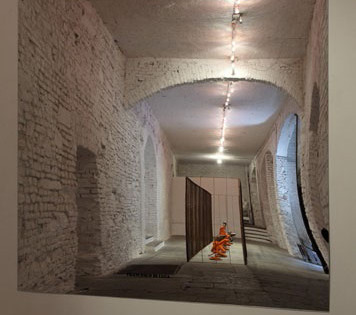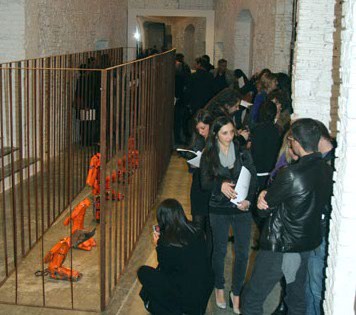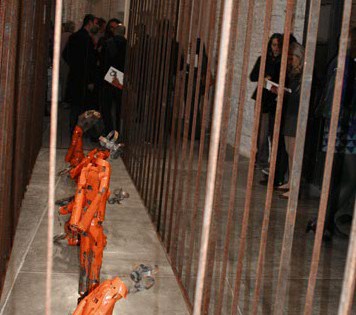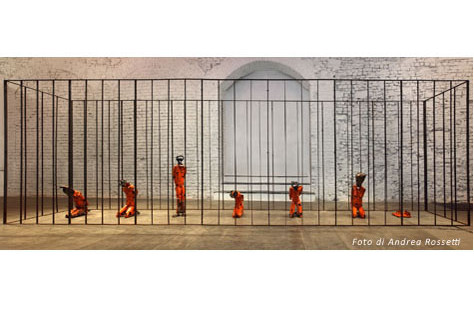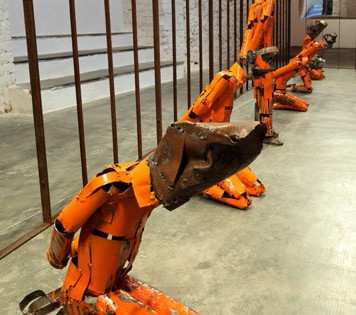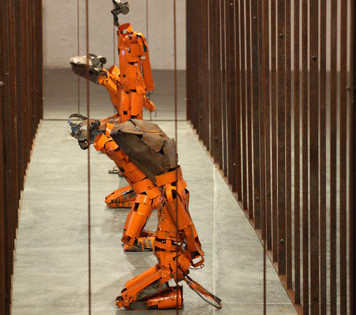FRANCESCO DI LUCA Cocoon, il senso dell’assenza
As written by Alessandro Baricco a few days ago in the pages of a popular national newspaper, change is taking place, “we are beyond a certain level of civilization”, we are also striding into a new era, worse or better at this moment we can not say, but certainly in tune with the time of today. I think it is time to understand how to deal with this change, how to relate in this new phase that belongs to us willy-nilly .
Equally certain is the role that each of us should have to collaborate, not hiding or simply define the current context as glossy superficiality with which we do not want to have anything to do.
Having chosen to devote myself to art, I can not believe its value, its content, its potential for expression and communication and especially in the analysis and thoughtful ideas that constantly flow from the work of artists. Constant exchange, close, unlimited that growing steadily by supplying a visual “concrete poetry” in relation to what apparently can not be grasped. Francesco Diluca certainly acts in this direction, able to weave the gruelling creation, the indomitable survey on the contemporary and events through the artistic, so that we can fully identify with the question that raises itself. A clear postion, courageous, that does not just want to consider the item as a work of art only in itself, but as a priority that aims to identify with the essence of the subject.
The scenery is a world of sheets , in conjunction with small glazed metal bars, soldered to each other as individual experiences, memories and scars, that shape men whose sense of life stems from the spectrum of the absence.
The first survey of Diluca focused on new generation, looking at clothes, status-symbol, behavior and interaction whit the world around them. The result is that of an apparently structured generation, approved in a sort of fashion uniform which you can not subtract, that displays a fake security , but actually becomes a mask behind which often hides a fragile and insecure generation, with the only certainly not really know.
Here is that the physicality, the body becomes only a distant memory , the fading of the material, the flesh is not totally denied only by the persistence of the housing, which outlines more features and contours.
The investigation widens, it takes consistency and spreads in every aspect of social , creeping between the substrates of society , taking into account cause and effects of human behavior. Francesco Diluca seen in these twisted forms , in these human plates, a possibility of union, for the individual with the universal, particular and general, the sense of material world intelligible joint the extrinsic.
But then where is the body? The container can exist without the content? Which strange metamorphosis is happening to these men and why? Diluca focuses
himself precisely on these concerns trying to subvert every expectation , depicting an envelope, a cocoon seemingly lifeless , static and helpless, the presence of non-core, for us to consider and try to understand the meaning of the absence. An absence that calls, indeed forces us to evaluate and analyze the reason of this failure, finding its unit between the threads of a significant amount of material only to find the meaning of immaterial.
We must now continue the journey into the chrysalis, into the bowels of the body, between the plots of the soul and the ruminations of thought; sculptures that find the courage to break, then to penetrate within and for structuring the human skeleton.
A large cage, a prison with high oversize bars, specially incumbent on the human presence within recluse. They are the prisoner detained in the U.S. prison at Guantanamo. A place on the edge of the world, which in structure and mode of operation, more reminiscent of a concentration camp than a prison. Here there seems to have lost all value and all other rights, the only possibility remained the body is to kneel, a submission to the violence which ends with a renunciation of life. As it is defined unambiguously by the same Diluca , in this case “ the vacuum of the sculptures is induced”, caused by the evil that has nothing to obscure, indeed it is as bright as the sun, available to anyone glance , a ruthless deterrent that does not allow fears or regrets.
Those portraits are among the architects of a dialogue with the world , establishing a relationship of mutual exchange, continuous and close with the current assuming the symbols, the key features; driven by icons so you can definitely assimilate the external image, dive in the poetic absence recovering the existential sense.
The gaps are not only encouraged, or certainly should be better contextualized and analyzed in particular, considering the social and historical context in which they are created. In fact the works that portray a nazi soldier, a Klu Klux Klan representative and a potential kamikaze , bring attention to the creators of emptiness, to those who in this case produce only the absence of life.
The object and the subject are a single identity, a constant in and out, which also involves the eye of the viewer, who lost the usual landmarks sensory, so seems to find the invisible visible.
Artist is the one who should invite to reflection, but also the Virgil who takes us on a journey, leading us into an area, do not say unknown, but we have not yet scoured in all its facets.
Well Diluca able to implement a story in pictures, where the subjects of his works make a transcendental journey in which they are first identified, analyzed, deconstructed, and then returning to the world transformed into “tangible chimere.”
The metal loses its three-dimensional, but becomes support, tabula rasa on which the artist intervenes telling experiences, events, thoughts, that in
some cases become the visual revelation of that inner absence, hidden, silent and invisible in the sculptures.
Intensity and therefore a reflective and emotional extension which introduce us and accompany us in the U.S. universe , that Diluca represents in its symbols, in the overflowing strength, in the infinite potential, not to mention, however, the same contradictions, sometimes protruding into selfishness and relentless violence.
The words reveal us the process of his work: “The paintings on irons take shape through various passes. First of all with the use of photography and then through the use of a software to process images, then proceeding to the implementation of the physical work. A fundamental part of the work is focused on design, very graphic, which allows me to emphasize contrasts. Veils of anti-rust preserve the metal parts and maintain the light. “
The doors that lead to a focus opened on the everyday life, the places of the city, the buildings in the streets, the advertising signs. The daily life become protagonist, individual and collective such as road accidents, which make Andy Warhol ‘series Car crashes back to mind, of course analysis on a real problem, but also a way to exorcise the unexpected death.
Rust invades the space, the metal surface, like a woodworm that runs unstoppable in the mind, expands, goes down to our inner, takes hold of the memories, revealing a new dimension, sometimes forgotten, curled and brushed aside, here is intensifying its way thought and senses .The work of art, as André Malraux reminds us, is not only execution, but birth, is life in the face of life.
___________________________________________________________________
Francesco Di Luca - Il senso dell’assenza
Testo di A.M.Martini
Come ha scritto Alessandro Baricco alcuni giorni or sono sulle pagine di un noto quotidiano nazionale, il cambiamento è in atto, “siamo oltre una certa civiltà”, ci stiamo inoltrando a grandi passi in una nuova epoca, peggiore o migliore questo al momento non possiamo dirlo, ma sicuramente in sintonia con il tempo dell’oggi. A mio avviso si tratta ora di capire come affrontare tale cambiamento, come relazionarci all’interno di questa nuova fase, che volenti o nolenti ci appartiene.
Altrettanto certo è il compito che ognuno di noi dovrebbe avere nel collaborare, non nascondendosi o limitandosi a definire il contesto attuale come superficialità patinata con la quale non vogliamo avere nulla a che fare.
Avendo scelto di dedicarmi all’arte, non posso non credere al suo valore, ai suoi contenuti, alle sue potenzialità espressive e comunicative e soprattutto nell’analisi e negli spunti riflessivi che costantemente sgorgano dal lavoro degli artisti. Scambio costante, serrato, illimitato che cresce costantemente fornendo una visuale “concretamente poetica” in relazione a ciò che solo apparentemente non può essere afferrato. Francesco Di Luca agisce certamente in questa direzione, riuscendo ad intrecciare l’estenuante creazione, l’indomabile indagine sulla contemporaneità e sugli avvenimenti attraverso il fare artistico, in modo che si possa perfettamente identificare con l’interrogativo che esso stesso suscita. Una presa di posizione netta, coraggiosa, che non si limita a voler considerare l’elemento artistico “solo” come opera in sé, ma come priorità che aspira ad identificarsi con l’ essenza del soggetto ritratto.
Lo scenario è un mondo di lamiere, materico nella congiunzione di piccole barre di metallo smaltate, che saldate tra di loro come singole esperienze, cicatrici e ricordi, plasmano uomini il cui senso vitale trae origine dallo spettro dell’assenza.
La prima indagine di Di Luca si era orientata sulle nuove generazioni, esaminandone l’abbigliamento, gli status-symbol, i comportamenti e l’interazione con il mondo che li circonda. Il risultato scaturito è quello di una generazione solo apparentemente “strutturata”, omologata all’interno di una sorta di divisa fashion, alla quale non ci si può sottrarre, che ostenta una fittizia sicurezza, ma che in realtà diviene una maschera dietro la quale si nasconde una generazione spesso fragile, insicura e con la sola certezza di non conoscersi realmente.
Ecco che la fisicità, il corpo diviene solo un ricordo lontano, la dissolvenza della materia, della carne non viene totalmente negata solo grazie alla persistenza dell’involucro, che ne delinea ancora contorni e fattezze.
L’indagine si amplia, prende consistenza e si propaga in ogni aspetto del sociale, insinuandosi tra i substrati della società, prendendo in considerazione causa ed effetti del comportamento umano. Francesco Di Luca vede in queste forme attorcigliate, in queste lamiere umane, una possibilità di unione del singolo con l’universale, il particolare e il generale, il senso dell’intellegibile congiunto all’estrinsecazione del mondo sensibile.
Ma allora dov’è finito il corpo? Può esistere il contenitore senza il contenuto? Quale strana metamorfosi sta accadendo a questi uomini e perché? È proprio su questi quesiti, su questi dubbi che Di Luca si concentra provando a sovvertire ogni possibile aspettativa, raffigurando un involucro, un bozzolo apparentemente privo di vita, statico ed inerme, l’anima della non presenza, per indurci a considerare e provare a comprendere il senso dell’assenza. Un’assenza che obbligatoriamente invita, anzi costringe a valutare ed analizzare il motivo di tale mancanza, trovando così paradossalmente la propria unità tra le trame del sensibile, del materico, per poi trovare il significato nell’immateriale.
Si tratta ora di continuare il viaggio all’interno della crisalide, nelle viscere del corpo, tra le trame dell’anima e le elucubrazioni del pensiero; sculture che trovano il coraggio della rottura, per poi addentrarsi nell’intimo e nella strutturazione dell’ossatura umana.
Una grande gabbia, una prigione con alte sbarre fuori misura, appositamente incombente sulle presenze umane recluse all’interno. Sono i prigionieri reclusi nella prigione americana di Guantanamo, un luogo ai limiti del mondo, che nella struttura e nelle modalità di gestione, ricorda più un campo di concentramento che una prigione. Qui l’esistere sembra avere perduto ogni valore e ogni diritto, l’unica possibilità e forza rimasta al corpo è quella di inginocchiarsi, una sottomissione alla violenza, che si conclude con una rinuncia alla vita. Come viene definito in modo inequivocabile dallo stesso Di Luca, in questo caso “il vuoto delle sculture è indotto”, provocato da quel male che di oscuro non ha più nulla, anzi è luminoso come la luce del sole, disponibile allo sguardo di chiunque, uno spietato deterrente che non ammette lacrime o pentimenti.
I soggetti ritratti da Francesco Di Luca sono gli artefici di un dialogo con il mondo, instaurano un rapporto di scambio reciproco, continuo e serrato con l’attuale, assumendone i simboli, gli elementi caratterizzanti; si lasciano trascinare dalle icone in modo da poter poi una volta assimilatane definitivamente l’immagine esterna, immergersi nell’assenza poetica recuperandone il senso esistenziale.
I vuoti non vengono solamente indotti, o meglio vanno certamente contestualizzati ed analizzati nello specifico, considerandone anche il contesto sociale e storico nel quale si creano. Le opere infatti che ritraggono un soldato nazista, un rappresentante del Klu Klux Klan e un potenziale kamikaze, riportano l’attenzione sugli artefici del vuoto, su coloro che in questo caso producono solo assenza di vita. L’oggetto e il soggetto trovano un’unica identità, un dentro e fuori incessante, che investe anche lo sguardo del fruitore, il quale perdendo gli usuali punti di riferimento sensoriali, sembra poter trovare il visibile nell’invisibile.
L’artista è colui che dovrebbe invitare alla riflessione, ma anche il Virgilio che ci accompagna in un viaggio, conducendoci in un territorio, non dico ignoto, ma che ancora non abbiamo perlustrato in tutte le sue sfaccettature. Ebbene Di Luca riesce a mettere in atto un racconto per immagini, dove i soggetti delle sue opere compiono un itinerario trascendentale nel quale prima vengono identificati, analizzati, destrutturati, per poi far ritorno nel mondo trasfigurati in “tangibili chimere”.
La lamiera perde la sua tridimensionalità, ma diviene supporto, tabula rasa sulla quale l’artista intervenire narrando esperienze, avvenimenti, riflessioni, che in alcuni casi divengono la rivelazione visiva di quell’intima assenza, nascosta, silenziosa e non visibile nelle sculture.
Un’intensità e perciò un prolungamento riflessivo ed emotivo che ci introducono e ci accompagnano nell’universo americano, che Di Luca rappresenta nei suoi simboli, nella straripante forza, nelle infinite potenzialità, non tralasciandone però le altrettanto molteplici contraddizioni, a volte debordanti in egoismo ed inesorabile violenza.
Sono le parole di Di Luca a svelarci il procedimento del suo lavoro: “I dipinti su ferro prendono forma attraverso vari passaggi. In primis con l’utilizzo della fotografia e poi tramite l’uso di un software per elaborare le immagini, procedendo infine alla realizzazione fisica dell’opera. Una parte fondamentale del lavoro è concentrata sul disegno, molto grafico, il quale mi permette di enfatizzare i contrasti. Velature di antiruggine preservano le parti ferrose da mantenere in luce”.
Si aprono le porte che conducono ad un’attenzione per il quotidiano, la vita di tutti i giorni, i luoghi della metropoli, i palazzi le vie, gli edifici, le insegne pubblicitarie. Divengono protagonisti anche i fatti quotidiani, individuali e collettivi come gli incidenti stradali, che fanno ritornare alla mente la serie Car crash di Andy Warhol, certamente un’analisi riguardante una problematica reale, ma anche un modo per esorcizzare l’inaspettata morte.
La ruggine invade lo spazio, la superficie metallica, come un tarlo che scorre inarrestabile nella mente, si espande, scende nel nostro intimo, si impadronisce dei ricordi, svelandone un dimensione inedita, a volte dimenticata, accartocciata e messa da parte, che qui si fa strada intensificandone il pensiero e i sensi. L’opera d’arte, come ci ricorda André Malraux , non è solo esecuzione, ma nascita, è la vita in faccia alla vita.
Equally certain is the role that each of us should have to collaborate, not hiding or simply define the current context as glossy superficiality with which we do not want to have anything to do.
Having chosen to devote myself to art, I can not believe its value, its content, its potential for expression and communication and especially in the analysis and thoughtful ideas that constantly flow from the work of artists. Constant exchange, close, unlimited that growing steadily by supplying a visual “concrete poetry” in relation to what apparently can not be grasped. Francesco Diluca certainly acts in this direction, able to weave the gruelling creation, the indomitable survey on the contemporary and events through the artistic, so that we can fully identify with the question that raises itself. A clear postion, courageous, that does not just want to consider the item as a work of art only in itself, but as a priority that aims to identify with the essence of the subject.
The scenery is a world of sheets , in conjunction with small glazed metal bars, soldered to each other as individual experiences, memories and scars, that shape men whose sense of life stems from the spectrum of the absence.
The first survey of Diluca focused on new generation, looking at clothes, status-symbol, behavior and interaction whit the world around them. The result is that of an apparently structured generation, approved in a sort of fashion uniform which you can not subtract, that displays a fake security , but actually becomes a mask behind which often hides a fragile and insecure generation, with the only certainly not really know.
Here is that the physicality, the body becomes only a distant memory , the fading of the material, the flesh is not totally denied only by the persistence of the housing, which outlines more features and contours.
The investigation widens, it takes consistency and spreads in every aspect of social , creeping between the substrates of society , taking into account cause and effects of human behavior. Francesco Diluca seen in these twisted forms , in these human plates, a possibility of union, for the individual with the universal, particular and general, the sense of material world intelligible joint the extrinsic.
But then where is the body? The container can exist without the content? Which strange metamorphosis is happening to these men and why? Diluca focuses
himself precisely on these concerns trying to subvert every expectation , depicting an envelope, a cocoon seemingly lifeless , static and helpless, the presence of non-core, for us to consider and try to understand the meaning of the absence. An absence that calls, indeed forces us to evaluate and analyze the reason of this failure, finding its unit between the threads of a significant amount of material only to find the meaning of immaterial.
We must now continue the journey into the chrysalis, into the bowels of the body, between the plots of the soul and the ruminations of thought; sculptures that find the courage to break, then to penetrate within and for structuring the human skeleton.
A large cage, a prison with high oversize bars, specially incumbent on the human presence within recluse. They are the prisoner detained in the U.S. prison at Guantanamo. A place on the edge of the world, which in structure and mode of operation, more reminiscent of a concentration camp than a prison. Here there seems to have lost all value and all other rights, the only possibility remained the body is to kneel, a submission to the violence which ends with a renunciation of life. As it is defined unambiguously by the same Diluca , in this case “ the vacuum of the sculptures is induced”, caused by the evil that has nothing to obscure, indeed it is as bright as the sun, available to anyone glance , a ruthless deterrent that does not allow fears or regrets.
Those portraits are among the architects of a dialogue with the world , establishing a relationship of mutual exchange, continuous and close with the current assuming the symbols, the key features; driven by icons so you can definitely assimilate the external image, dive in the poetic absence recovering the existential sense.
The gaps are not only encouraged, or certainly should be better contextualized and analyzed in particular, considering the social and historical context in which they are created. In fact the works that portray a nazi soldier, a Klu Klux Klan representative and a potential kamikaze , bring attention to the creators of emptiness, to those who in this case produce only the absence of life.
The object and the subject are a single identity, a constant in and out, which also involves the eye of the viewer, who lost the usual landmarks sensory, so seems to find the invisible visible.
Artist is the one who should invite to reflection, but also the Virgil who takes us on a journey, leading us into an area, do not say unknown, but we have not yet scoured in all its facets.
Well Diluca able to implement a story in pictures, where the subjects of his works make a transcendental journey in which they are first identified, analyzed, deconstructed, and then returning to the world transformed into “tangible chimere.”
The metal loses its three-dimensional, but becomes support, tabula rasa on which the artist intervenes telling experiences, events, thoughts, that in
some cases become the visual revelation of that inner absence, hidden, silent and invisible in the sculptures.
Intensity and therefore a reflective and emotional extension which introduce us and accompany us in the U.S. universe , that Diluca represents in its symbols, in the overflowing strength, in the infinite potential, not to mention, however, the same contradictions, sometimes protruding into selfishness and relentless violence.
The words reveal us the process of his work: “The paintings on irons take shape through various passes. First of all with the use of photography and then through the use of a software to process images, then proceeding to the implementation of the physical work. A fundamental part of the work is focused on design, very graphic, which allows me to emphasize contrasts. Veils of anti-rust preserve the metal parts and maintain the light. “
The doors that lead to a focus opened on the everyday life, the places of the city, the buildings in the streets, the advertising signs. The daily life become protagonist, individual and collective such as road accidents, which make Andy Warhol ‘series Car crashes back to mind, of course analysis on a real problem, but also a way to exorcise the unexpected death.
Rust invades the space, the metal surface, like a woodworm that runs unstoppable in the mind, expands, goes down to our inner, takes hold of the memories, revealing a new dimension, sometimes forgotten, curled and brushed aside, here is intensifying its way thought and senses .The work of art, as André Malraux reminds us, is not only execution, but birth, is life in the face of life.
___________________________________________________________________
Francesco Di Luca - Il senso dell’assenza
Testo di A.M.Martini
Come ha scritto Alessandro Baricco alcuni giorni or sono sulle pagine di un noto quotidiano nazionale, il cambiamento è in atto, “siamo oltre una certa civiltà”, ci stiamo inoltrando a grandi passi in una nuova epoca, peggiore o migliore questo al momento non possiamo dirlo, ma sicuramente in sintonia con il tempo dell’oggi. A mio avviso si tratta ora di capire come affrontare tale cambiamento, come relazionarci all’interno di questa nuova fase, che volenti o nolenti ci appartiene.
Altrettanto certo è il compito che ognuno di noi dovrebbe avere nel collaborare, non nascondendosi o limitandosi a definire il contesto attuale come superficialità patinata con la quale non vogliamo avere nulla a che fare.
Avendo scelto di dedicarmi all’arte, non posso non credere al suo valore, ai suoi contenuti, alle sue potenzialità espressive e comunicative e soprattutto nell’analisi e negli spunti riflessivi che costantemente sgorgano dal lavoro degli artisti. Scambio costante, serrato, illimitato che cresce costantemente fornendo una visuale “concretamente poetica” in relazione a ciò che solo apparentemente non può essere afferrato. Francesco Di Luca agisce certamente in questa direzione, riuscendo ad intrecciare l’estenuante creazione, l’indomabile indagine sulla contemporaneità e sugli avvenimenti attraverso il fare artistico, in modo che si possa perfettamente identificare con l’interrogativo che esso stesso suscita. Una presa di posizione netta, coraggiosa, che non si limita a voler considerare l’elemento artistico “solo” come opera in sé, ma come priorità che aspira ad identificarsi con l’ essenza del soggetto ritratto.
Lo scenario è un mondo di lamiere, materico nella congiunzione di piccole barre di metallo smaltate, che saldate tra di loro come singole esperienze, cicatrici e ricordi, plasmano uomini il cui senso vitale trae origine dallo spettro dell’assenza.
La prima indagine di Di Luca si era orientata sulle nuove generazioni, esaminandone l’abbigliamento, gli status-symbol, i comportamenti e l’interazione con il mondo che li circonda. Il risultato scaturito è quello di una generazione solo apparentemente “strutturata”, omologata all’interno di una sorta di divisa fashion, alla quale non ci si può sottrarre, che ostenta una fittizia sicurezza, ma che in realtà diviene una maschera dietro la quale si nasconde una generazione spesso fragile, insicura e con la sola certezza di non conoscersi realmente.
Ecco che la fisicità, il corpo diviene solo un ricordo lontano, la dissolvenza della materia, della carne non viene totalmente negata solo grazie alla persistenza dell’involucro, che ne delinea ancora contorni e fattezze.
L’indagine si amplia, prende consistenza e si propaga in ogni aspetto del sociale, insinuandosi tra i substrati della società, prendendo in considerazione causa ed effetti del comportamento umano. Francesco Di Luca vede in queste forme attorcigliate, in queste lamiere umane, una possibilità di unione del singolo con l’universale, il particolare e il generale, il senso dell’intellegibile congiunto all’estrinsecazione del mondo sensibile.
Ma allora dov’è finito il corpo? Può esistere il contenitore senza il contenuto? Quale strana metamorfosi sta accadendo a questi uomini e perché? È proprio su questi quesiti, su questi dubbi che Di Luca si concentra provando a sovvertire ogni possibile aspettativa, raffigurando un involucro, un bozzolo apparentemente privo di vita, statico ed inerme, l’anima della non presenza, per indurci a considerare e provare a comprendere il senso dell’assenza. Un’assenza che obbligatoriamente invita, anzi costringe a valutare ed analizzare il motivo di tale mancanza, trovando così paradossalmente la propria unità tra le trame del sensibile, del materico, per poi trovare il significato nell’immateriale.
Si tratta ora di continuare il viaggio all’interno della crisalide, nelle viscere del corpo, tra le trame dell’anima e le elucubrazioni del pensiero; sculture che trovano il coraggio della rottura, per poi addentrarsi nell’intimo e nella strutturazione dell’ossatura umana.
Una grande gabbia, una prigione con alte sbarre fuori misura, appositamente incombente sulle presenze umane recluse all’interno. Sono i prigionieri reclusi nella prigione americana di Guantanamo, un luogo ai limiti del mondo, che nella struttura e nelle modalità di gestione, ricorda più un campo di concentramento che una prigione. Qui l’esistere sembra avere perduto ogni valore e ogni diritto, l’unica possibilità e forza rimasta al corpo è quella di inginocchiarsi, una sottomissione alla violenza, che si conclude con una rinuncia alla vita. Come viene definito in modo inequivocabile dallo stesso Di Luca, in questo caso “il vuoto delle sculture è indotto”, provocato da quel male che di oscuro non ha più nulla, anzi è luminoso come la luce del sole, disponibile allo sguardo di chiunque, uno spietato deterrente che non ammette lacrime o pentimenti.
I soggetti ritratti da Francesco Di Luca sono gli artefici di un dialogo con il mondo, instaurano un rapporto di scambio reciproco, continuo e serrato con l’attuale, assumendone i simboli, gli elementi caratterizzanti; si lasciano trascinare dalle icone in modo da poter poi una volta assimilatane definitivamente l’immagine esterna, immergersi nell’assenza poetica recuperandone il senso esistenziale.
I vuoti non vengono solamente indotti, o meglio vanno certamente contestualizzati ed analizzati nello specifico, considerandone anche il contesto sociale e storico nel quale si creano. Le opere infatti che ritraggono un soldato nazista, un rappresentante del Klu Klux Klan e un potenziale kamikaze, riportano l’attenzione sugli artefici del vuoto, su coloro che in questo caso producono solo assenza di vita. L’oggetto e il soggetto trovano un’unica identità, un dentro e fuori incessante, che investe anche lo sguardo del fruitore, il quale perdendo gli usuali punti di riferimento sensoriali, sembra poter trovare il visibile nell’invisibile.
L’artista è colui che dovrebbe invitare alla riflessione, ma anche il Virgilio che ci accompagna in un viaggio, conducendoci in un territorio, non dico ignoto, ma che ancora non abbiamo perlustrato in tutte le sue sfaccettature. Ebbene Di Luca riesce a mettere in atto un racconto per immagini, dove i soggetti delle sue opere compiono un itinerario trascendentale nel quale prima vengono identificati, analizzati, destrutturati, per poi far ritorno nel mondo trasfigurati in “tangibili chimere”.
La lamiera perde la sua tridimensionalità, ma diviene supporto, tabula rasa sulla quale l’artista intervenire narrando esperienze, avvenimenti, riflessioni, che in alcuni casi divengono la rivelazione visiva di quell’intima assenza, nascosta, silenziosa e non visibile nelle sculture.
Un’intensità e perciò un prolungamento riflessivo ed emotivo che ci introducono e ci accompagnano nell’universo americano, che Di Luca rappresenta nei suoi simboli, nella straripante forza, nelle infinite potenzialità, non tralasciandone però le altrettanto molteplici contraddizioni, a volte debordanti in egoismo ed inesorabile violenza.
Sono le parole di Di Luca a svelarci il procedimento del suo lavoro: “I dipinti su ferro prendono forma attraverso vari passaggi. In primis con l’utilizzo della fotografia e poi tramite l’uso di un software per elaborare le immagini, procedendo infine alla realizzazione fisica dell’opera. Una parte fondamentale del lavoro è concentrata sul disegno, molto grafico, il quale mi permette di enfatizzare i contrasti. Velature di antiruggine preservano le parti ferrose da mantenere in luce”.
Si aprono le porte che conducono ad un’attenzione per il quotidiano, la vita di tutti i giorni, i luoghi della metropoli, i palazzi le vie, gli edifici, le insegne pubblicitarie. Divengono protagonisti anche i fatti quotidiani, individuali e collettivi come gli incidenti stradali, che fanno ritornare alla mente la serie Car crash di Andy Warhol, certamente un’analisi riguardante una problematica reale, ma anche un modo per esorcizzare l’inaspettata morte.
La ruggine invade lo spazio, la superficie metallica, come un tarlo che scorre inarrestabile nella mente, si espande, scende nel nostro intimo, si impadronisce dei ricordi, svelandone un dimensione inedita, a volte dimenticata, accartocciata e messa da parte, che qui si fa strada intensificandone il pensiero e i sensi. L’opera d’arte, come ci ricorda André Malraux , non è solo esecuzione, ma nascita, è la vita in faccia alla vita.

